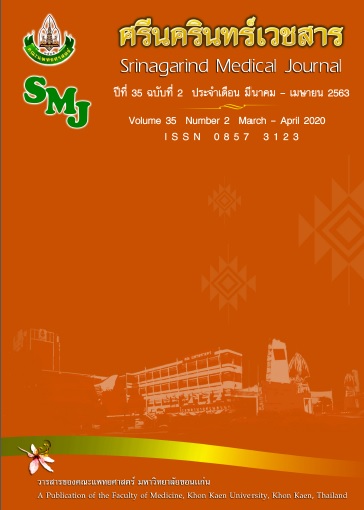Clinical Presentation and Outcome of Acute Pulmonary Embolism in Emergency Department, University Hospital, Northeast, Thailand
Keywords:
acute pulmonary embolism; clinical presentation; emergency departmentAbstract
Background and objective: The incidence of acute pulmonary embdism (APE) in Thailand are unknown. With new diagnostic tools and current advanced knowledge, APE was discovered to be much more frequent in Thailand than earlier believed. Clinical outcome of APE had not been previously firmly identified. The aim of this study was to evaluation signs, symptoms, laboratory data, treatments and outcomes of patients diagnosed with APE in emergency department (ED).
Methods: The study design was retrospective descriptive study. We searched electronic databases (Jan. 2008 – Nov. 2018) for patients with suspected APE and diagnosed by computed tomographic pulmonary angiography (CTPA) in Srinagarind hospital.
Results: A total of 110 patients with confirmed APE was enrolled from ED. 67 patients were female (60.91%). The age of patients varied from 22 to 91 years old. The mean age was 62.4 years old. Malignancy was the most frequent co-morbidity (48.18%). The most common presenting symptoms and signs were dyspnea (86.36%), followed by tachypnea (66.36%) and tachycardia (50.91%). The most frequent radiographic abnormalities were pulmonary parenchymal lesions (40.91%). Most electrocardiograms were sinus tachycardia (50%). Echocardiography findings were RV dilatation in most cases (48.44%). D-dimer, Troponin-T and NT pro-BNP were increased in patients with APE. The mortality rate at the hospital admission was 5 in 110 patients (4.55%).
Conclusion: The most common clinical characteristics of APE patients in ED were dyspnea similar to previous reports in other countries. The mortality rate showed no difference when compared to previous studies.
References
2. Horlander KT, Mannino DM, Leeper KV. Pulmonary embolism mortality in the United States, 1979-1998: an analysis using multiple-cause mortality data. Arch Intern Med 2003; 163: 1711–7.
3. Aniwan S, Rojnuckarin P. High incidence of symptomatic venous thromboembolism in Thai hospitalized medical patients without thromboprophylaxis: Blood Coagul Fibrinolysis 2010; 21: 334–8.
4. Konstantinides SV, Torbicki A, Agnelli G, Danchin N, Fitzmaurice D, Galiè N, et al. 2014 ESC Guidelines on the diagnosis and management of acute pulmonary embolismThe Task Force for the Diagnosis and Management of Acute Pulmonary Embolism of the European Society of Cardiology (ESC)Endorsed by the European Respiratory Society (ERS). Eur Heart J 2014; 35: 3033-69.
5. Kline JA. Diagnosis and Exclusion of Pulmonary Embolism. Thromb Res 2018; 163: 207–20.
6. Konstantinides SV, Barco S, Lankeit M, Meyer G. Management of Pulmonary Embolism: An Update. J Am Coll Cardiol 2016; 67: 976–90.
7. Stein PD, Beemath A, Matta F, Weg JG, Yusen RD, Hales CA, et al. Clinical characteristics of patients with acute pulmonary embolism: data from PIOPED II. Am J Med 2007; 120: 871–9.
8. Kline JA, Kabrhel C. Emergency Evaluation for Pulmonary Embolism, Part 1: Clinical Factors that Increase Risk. J Emerg Med 2015; 48: 771–80.
9. Sompradeekul S, Ittimakin S. Clinical characteristics and outcome of thai patients with acute pulmonary embolism. J Med Assoc Thail Chotmaihet Thangphaet 2007; 90: 59–67.
10. Jaff Michael R., McMurtry M. Sean, Archer Stephen L., Cushman Mary, Goldenberg Neil, Goldhaber Samuel Z, et al. Management of Massive and Submassive Pulmonary Embolism, Iliofemoral Deep Vein Thrombosis, and Chronic Thromboembolic Pulmonary Hypertension. Circulation 2011; 123: 1788–830.
11. Sekhri V, Mehta N, Rawat N, Lehrman SG, Aronow WS. Management of massive and nonmassive pulmonary embolism. Arch Med Sci AMS 2012; 8: 957–69.
12. Lemeshow S, Hosmer DW, Klar J, Lwanga SK, Organization WH. Adequacy of sample size in health studies [Internet]. Chichester: Wiley; 1990 [cited Dec 27, 2018]. Available from: http://apps.who.int/iris/handle/10665/41607
13. Roy P-M, Moumneh T, Penaloza A, Sanchez O. Outpatient management of pulmonary embolism. Thromb Res 2017; 155: 92–100.
14. Liu MY, Ballard DW, Huang J, Rauchwerger AS, Reed ME, Bouvet SC, et al. Acute Pulmonary Embolism in Emergency Department Patients Despite Therapeutic Anticoagulation. West J Emerg Med 2018; 19: 510–6.
15. Pollack CV, Schreiber D, Goldhaber SZ, Slattery D, Fanikos J, O’Neil BJ, et al. Clinical Characteristics, Management, and Outcomes of Patients Diagnosed With Acute Pulmonary Embolism in the Emergency Department: Initial Report of EMPEROR (Multicenter Emergency Medicine Pulmonary Embolism in the Real World Registry). J Am Coll Cardiol 2011; 57: 700–6.
16. Bajaj N, Bozarth AL, Guillot J, KojoKittah J, Appalaneni SR, Cestero C, et al. Clinical features in patients with pulmonary embolism at a community hospital: analysis of 4 years of data. J Thromb Thrombolysis 2014; 37: 287–92.
17. Laher AE, Richards G. Cardiac arrest due to pulmonary embolism. Indian Heart J 2018; 70: 731–5.
18. Corrigan D, Prucnal C, Kabrhel C. Pulmonary embolism: the diagnosis, risk-stratification, treatment and disposition of emergency department patients. Clin Exp Emerg Med 2016; 3: 117–25.
19. Clinical Update. Clinical Presentations of Pulmonary Embolism in the Emergency Department : Journal of Cardiovascular Emergencies 2017; 3: 133-7
20. Crooks S, Lang E. Prevalence of pulmonary embolism in syncope patients. CJEM 2018; 20: 432–4.
21. Gruettner J, Walter T, Bolte M, Haghi D, Sudarski S, Henzler T. Incidence of Pulmonary Embolism in an Emergency Department Cohort Evaluated with a Simple Symptom-based Diagnostic Algorithm. In Vivo 2013; 27: 215–20.




